Colorado is not only the place where beauty and culture meet; it’s also an overflowing cornucopia of outdoor activity. The mountains are lofty peaks that frame the heavens for hikers and bikers, but it’s also the home of a world-class waterway that throws down the challenge to be met by rafters and kayakers from around the world. The rock star of Colorado rivers is the Arkansas River.
At its peak rush in spring, it’s a raging autobahn of a river, revved up and rampant with rapids. The portal to this kingdom of the kayak is located in Salida, where more than anything, kayaking is a true state of mind.
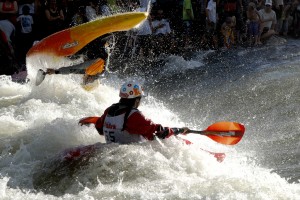 Towering over this playground in the background is Mt. Shavano; at more than 14,000 feet and 14 miles northwest of town, her snow-capped peak is the mother source of the spring snow melt. Her virginal snowcap begins to melt, exposing her magnificent peak—a virgin’s gown left to slowly fall to the floor. The snow warms from the sun, and begins to flow and race down the mountain emptying her energy and water into the Arkansas—faster, faster—to the point where the rapids are surging. They reach the range of category fives—what every true whitewater aficionado wants to tackle. The mother of all rapids, now on nature’s snow melt steroids, pumping powerful surges of water, while the adrenaline carves its own course, and races through the canyon.
Towering over this playground in the background is Mt. Shavano; at more than 14,000 feet and 14 miles northwest of town, her snow-capped peak is the mother source of the spring snow melt. Her virginal snowcap begins to melt, exposing her magnificent peak—a virgin’s gown left to slowly fall to the floor. The snow warms from the sun, and begins to flow and race down the mountain emptying her energy and water into the Arkansas—faster, faster—to the point where the rapids are surging. They reach the range of category fives—what every true whitewater aficionado wants to tackle. The mother of all rapids, now on nature’s snow melt steroids, pumping powerful surges of water, while the adrenaline carves its own course, and races through the canyon.
Grab a picnic and head to the local downtown park to watch the kayakers cavort in the “play holes” where they ride the mini rapids and do underwater flips. This is all in preparation for the watery journey downstream and gear-up for Paddlefest that kicks-off in June. Other activities for the ardent outdoors person abound from horseback riding, hiking and mountain biking trails, rock climbing and wildlife viewing.
In June it’s ground zero for challengers from around the world who embark on a 26-mile kayak challenge and course. The 65th annual FIBArk Whitewater Festival is a four-day extravaganza that runs this year from June 13-16, with competitors from around the world tackling a variety of events. The festival is also highlighted by free concerts, food, libations, and fun for family and friends—kayak or no kayak. Even if there is no festival, it’s a great afternoon in a pair of shorts wading in the mini rapids, enjoying the sun on your face, the mountains in the background, and a variety dogs that romp in the river chasing Frisbees.
The FIBArk events are challenging to say the least. For example, the Boater X Race has gained a fair share of notoriety and reputation as a true machismo test of speed and skills to showcase while tackling this powerful section of raging whitewater.
For the more freewheeling and adventurous kayakers can “saddle up” for the Freestyle Kayak Rodeo where they test themselves doing tricks and difficult maneuvers in a river hole or standing wave. It’s a symphony of coordination and skill with a menu of tricky-loo’s, spins and loops to gain valuable competitive points based on a paddlers style and the difficulty of the performance.
 Fun in the sun, yes, but the Godzilla of FIBArk events is the Classic Downriver Race that runs for 26 miles through a canyon maze of Class III rapids. It’s a difficult race that is a testament to endurance and stamina. So, it’s no wonder it’s regarded as one of, if not THE toughest races of its kind in North America that once accomplished, an individual can take pride in being “the best of the best” in this grueling athletic Holy Grail of kayaking.
Fun in the sun, yes, but the Godzilla of FIBArk events is the Classic Downriver Race that runs for 26 miles through a canyon maze of Class III rapids. It’s a difficult race that is a testament to endurance and stamina. So, it’s no wonder it’s regarded as one of, if not THE toughest races of its kind in North America that once accomplished, an individual can take pride in being “the best of the best” in this grueling athletic Holy Grail of kayaking.
Are you perhaps, kayak-challenged? Have no fear, the Rocky Mountain Outdoor Center is here—actually, they’re in Salida, and is the best of the best when it comes to teaching you all about the little nuances associated with this sport. They also rent boats, host tours, and provide rock-climbing instructors to teach you how to scale walls (rock climbing is also another favorite outdoor pastime in the region).
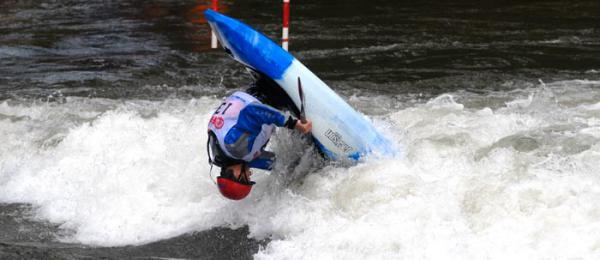 For a little less serious fun in the sun and in the rapids, join the Hooligan Race. River hooligans take to the water aboard some dubious crafts that defy the imagination and physics of buoyancy. It’s a free-for-all race that includes anything that will float (not actual boats). Bathtubs count, boats do not! It’s referred to by FIBArk aficionados as “controlled chaos” and is one of the highlights of the festival.
For a little less serious fun in the sun and in the rapids, join the Hooligan Race. River hooligans take to the water aboard some dubious crafts that defy the imagination and physics of buoyancy. It’s a free-for-all race that includes anything that will float (not actual boats). Bathtubs count, boats do not! It’s referred to by FIBArk aficionados as “controlled chaos” and is one of the highlights of the festival.
There are a few rules that are designed for environmental purposes as well as safety issues. No hazardous materials, batteries, generators or fuel of any type is allowed (as well as no furniture). Keep your mattresses in the bedroom and your love seats in the living room. If they go in the water it not only becomes a hazard and detrimental to wildlife in the area but it also affects the watershed eco-system.
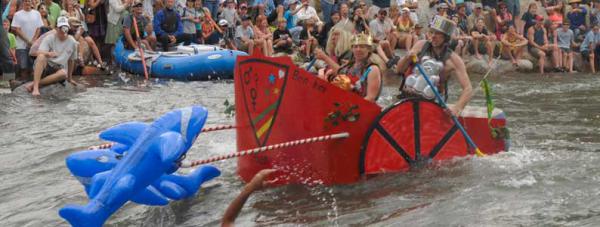 Camp it up in the outdoors in a truly rustic setting at any of the numerous campgrounds or RV parks, or add a little knotty pine romance by staying in a secluded log cabin in the pines. There are quaint “mom and pop” operations also to choose from at budget prices, as well as bed and breakfasts and luxury lodgings to spoil and pamper you in the Rocky Mountain setting of pines and mountains.
Camp it up in the outdoors in a truly rustic setting at any of the numerous campgrounds or RV parks, or add a little knotty pine romance by staying in a secluded log cabin in the pines. There are quaint “mom and pop” operations also to choose from at budget prices, as well as bed and breakfasts and luxury lodgings to spoil and pamper you in the Rocky Mountain setting of pines and mountains.
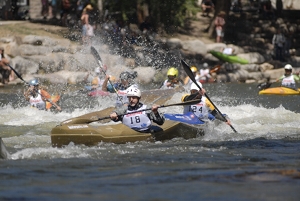 Nightlife is alive and well in Salida. So, after a day of shooting the rapids… kick back with a micro brew and live entertainment at any of the brewpubs. For dining options you can make it nouvelle cuisine or a beer and burger or a monster chili dog at the small cafe by the downtown park (my favorite place!).
Nightlife is alive and well in Salida. So, after a day of shooting the rapids… kick back with a micro brew and live entertainment at any of the brewpubs. For dining options you can make it nouvelle cuisine or a beer and burger or a monster chili dog at the small cafe by the downtown park (my favorite place!).
This is all outdoor adventure on steroids and it’s a true Rocky Mountain high. Set your kayak on a course for Salida, Colorado—the kayak kingdom of the Rocky Mountains.
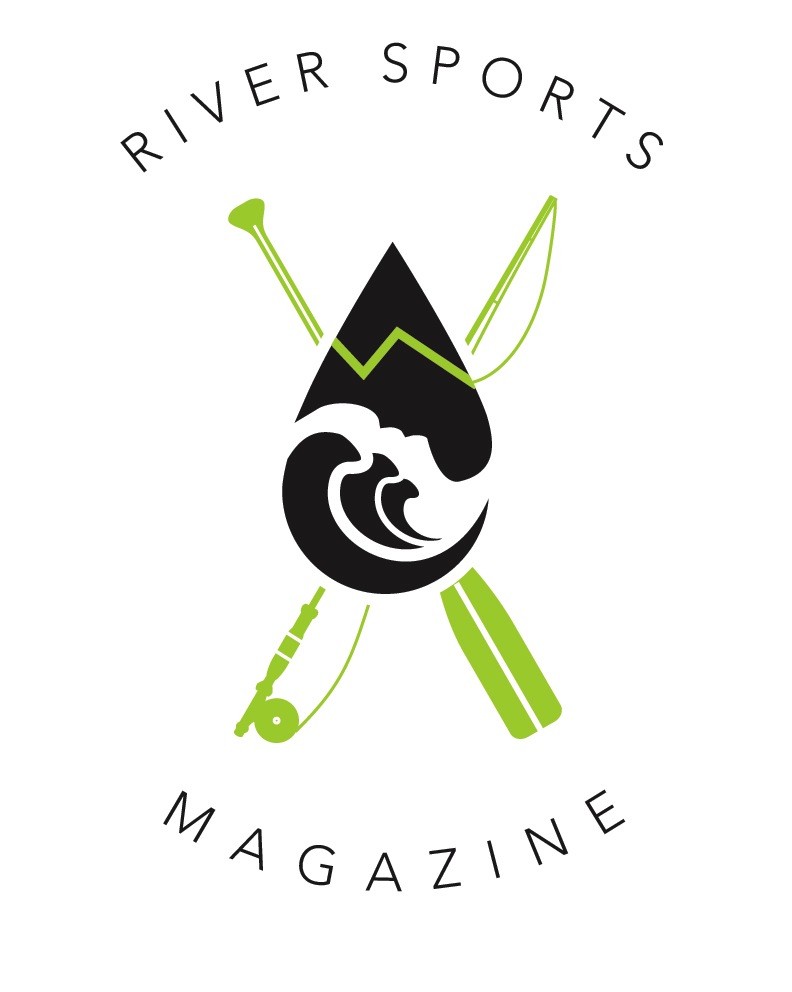
Kayaks are classified by their use. There are eight primary classifications: polo, slalom, whitewater, surf, touring/expedition, light touring/day tripping, sprint/racing and general recreation. From these primary classifications stem many sub-classes. For example, a fishing kayak is simply a general-recreation kayak outfitted with accessories that make it easier from which to fish. A creek kayak is a certain type of whitewater kayak, designed to handle narrow gully type rivers and falls. Also within these classifications are many levels of performance which further separate the individual models. In other words, not all touring kayaks handle the same.